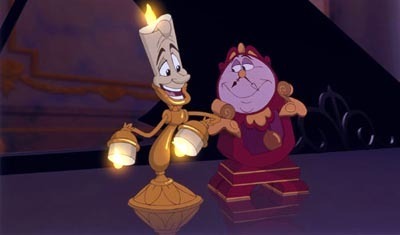
Fig 1: Belle et la Bete poster.
While most film viewers think of Disney's 'Beauty and the Beast' when confronted with the title, little do many know of the film's original inspiration: the fairytale and the 1946 French film, La Belle et la Bete.
The film was actually produced while France was still in the recovery stages of World War One.
Overall, the story remains faithful to the original fairytale, the story being that a merchant goes into town in hopes of making a profit only to leave with nothing. After getting caught in a violent storm, he ends up lost and finds his way to a wealthy looking castle. However, though the owner of the estate is not present he finds a table with food set out on it. After eating, he eventually falls asleep.

Fig 2: The Merchant finds the table full of food.
The next morning, he prepares to leave only to remember that he promised one of his daughters, Belle, the gift of a rose. He goes to the castle's garden and plucks one which subsiquently enrages the castle's only residant: the Beast. The merchant trades his daughter, Belle, for his life.
To begin with, the girl is initially disgusted by the Beast's appearence, but grows to love him throughout the rest of the film. The Beast lets her see her father and so while at home, one of her former suitors decides that he'll hunt down the Beast in order to 'save' her from it, but in an ironic twist is turned into a beast himself and the Beast to a man.

Fig 3: Daughter and the Beast still.
Disney, when making the animation version of the film, watered down plenty of elements and added in plenty more such as the curse upon the Beast to turn him into a beast in the first place. He also embelished upon the animate household appliances that we see limited to statues and candlesticks in the 1946 film. The curse caused all the rest of the house's residents to turn into furnature and appliances.
"Jean Cocteau's interpretation of the myth, drawing its inspiration from Mme Leprince de Beaumont's mid-18th century version of the tale, presents viewers with an awkward combination of adult sophistication and childish naivete."
-Brown

Fig 4: Lumierre and Cogsworth from the Disney rendition, primarily used as comic relief.
Both films convey the strong message of 'Do not judge one by their exterior' and both do it very well.
"The tale is presented so purely that a great number of themes can be read into it, like all great fables, but the prevailing one seems to be not so much that love conquers all, more that if you look beneath the surface the most unlikely people not only can be loved, but can be capable of great love even if it is not reciprocated.
The director, Jean Cocteau, used a lot of experimental film techniques, which is why it was renowned for its time and which is also why it still resonates until this day."
-Graeme Clark
Bibliography
http://www.thespinningimage.co.uk/cultfilms/displaycultfilm.asp?reviewid=1394
http://www.eyeforfilm.co.uk/reviews.php?id=1555
Illustration List
Fig 1: http://www.411mania.com/siteimages/labelleetlabete_75740.jpg
Fig 4: http://adventureinthegreatwidesomewhere.files.wordpress.com/2011/05/lumiere-and-cogsworth2.jpg

No comments:
Post a Comment